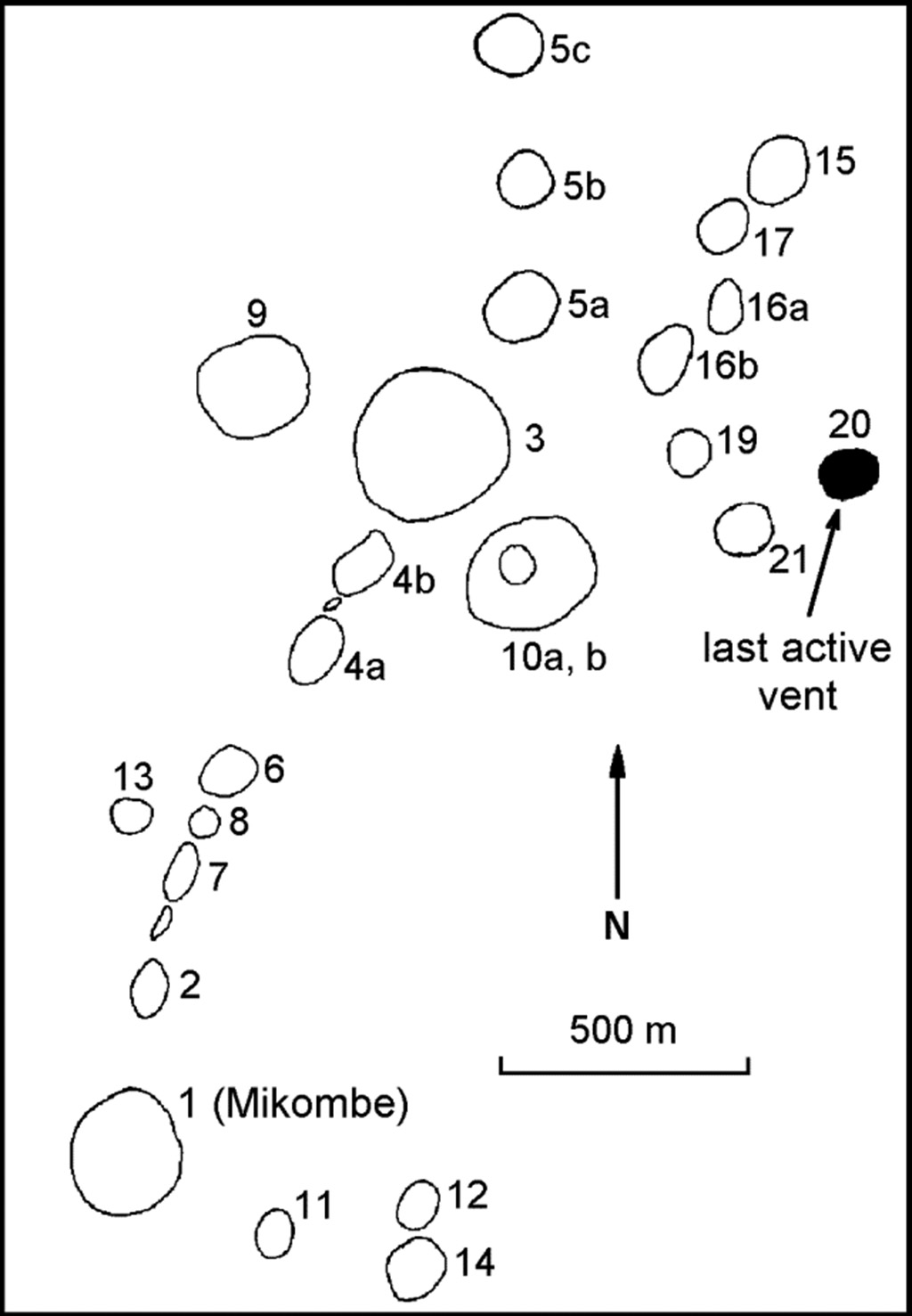Report on Nyamulagira (DR Congo) — June 1992
Bulletin of the Global Volcanism Network, vol. 17, no. 6 (June 1992)
Managing Editor: Lindsay McClelland.
Nyamulagira (DR Congo) Continued lava production from fissure vents
Please cite this report as:
Global Volcanism Program, 1992. Report on Nyamulagira (DR Congo) (McClelland, L., ed.). Bulletin of the Global Volcanism Network, 17:6. Smithsonian Institution. https://doi.org/10.5479/si.GVP.BGVN199206-223020
Nyamulagira
DR Congo
1.408°S, 29.2°E; summit elev. 3058 m
All times are local (unless otherwise noted)
Vigorous lava production continued through June . . . . The eruption has built 23 cinder cones along a 2.5-km zone that trends generally NE, ~15 km NE of Nyamuragira caldera and 5 km ENE of the 1957 Kitsimbanyi vent (figure 12 and table 1). The eruption's early phases produced substantial lava flows, but since 20 November activity has been characterized by vigorous ejection of bombs, lava fragments, and ash, with lava flows of only limited extent.
Table 1. Sequence of activity at Nyamuragira's 1991-92 eruption vents. Locations are shown on figure 12. Some small, short-lived vents removed by subsequent lava flows are not listed.
| Cone | First Activity | Comments |
| 1 | 24 Sep 1991 | Named Mikombe. |
| 2 | 24 Oct 1991 | -- |
| 3 | 25 Oct 1991 | Through 3 Feb 1992. |
| 4a, b | 07 Nov 1991 | -- |
| 5a, b, c | 08 Nov 1991 | On 24 November 1991 only cone 5 was active. |
| 6 | 10 Nov 1991 | -- |
| 7 | 11 Nov 1991 | -- |
| 8 | 23 Dec 1991 | -- |
| 9 | 06 Feb 1992 | -- |
| 10a, b | 26 Feb 1992 | -- |
| 11 | 08 Mar 1992 | -- |
| 12 | 10 Mar 1992 | -- |
| 13 | 12 Mar 1992 | -- |
| 14 | 16 Mar 1992 | Still active in May. |
| 15 | 08 May 1992 | -- |
| 16a, b | 10 May 1992 | Cones 14-17 still active through the end of May. |
| 16b | 10 May 1992 | -- |
| 17 | 11 May 1992 | -- |
| 18 | 24 May 1992 | -- |
| 19 | 05 Jul 1992 | Cones 19-21 still intermittently active through August 1992. |
| 20 | 14 Jul 1992 | -- |
| 21 | 19 Jul 1992 | -- |
From 20 September until 5 February, activity was confined to a N32-34°E fissure (cones 1-8). The most persistent activity at a single vent, 25 October-3 February, has made Cone 3 the largest of the eruption, rising ~80 m above the surrounding lava plain. Three new cones developed in February, nos. 9 (6 February), 10a and 10b (26 February). In March, activity resumed at the S end of the fissure along a branch that trended E from the initial vent, successively building cones 11, 12, and 14. Vent 13, 1 km to the N, erupted during the same period.
In early May, activity moved to the N end of the fissure, as a NE branch developed and formed vents 15-17. These vents remained active at the end of May, as did no. 14 at the S end of the fissure, producing intermittent lava fountains. Vent 18, near the middle of the fissure, began to erupt at about 1100 on 24 May. By 8 June it had grown to ~25 m height and its lava flows had extended ~3 km N, eroding away cones 10a and 10b. Activity at the new vent was preceded by an increase in microtremor amplitude recorded at a seismic station (Katale) 12 km E. Amplitude increased significantly from 8 June, indicating movement of new magma from a deeper source. As of 1 July, there was no indication that the eruption was nearing its end. Lava production remained vigorous, with high lava fountains, and strong emission of bombs and other tephra.
Geological Summary. Africa's most active volcano, Nyamulagira (also known as Nyamuragira), is a massive high-potassium basaltic shield about 25 km N of Lake Kivu and 13 km NNW of the steep-sided Nyiragongo volcano. The summit is truncated by a small 2 x 2.3 km caldera that has walls up to about 100 m high. Documented eruptions have occurred within the summit caldera, as well as from the numerous flank fissures and cinder cones. A lava lake in the summit crater, active since at least 1921, drained in 1938, at the time of a major flank eruption. Recent lava flows extend down the flanks more than 30 km from the summit as far as Lake Kivu; extensive lava flows from this volcano have covered 1,500 km2 of the western branch of the East African Rift.
Information Contacts: N. Zana, CRSN, Bukavu.


